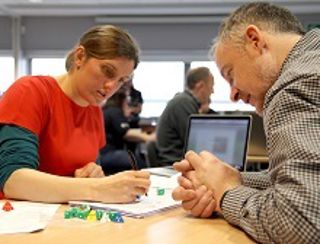
Astro Academy is highlight of successful Symposium
- 18th May 2016
The National Space Academy Symposium is an opportunity for all of the National Space Academy staff, core team and Lead Educators, to review the past 12 months, and also look to new and exciting projects for the future. This year, the pinnacle of the Symposium was the demonstration of the soon to be released Astro Academy: Principia teacher resources.
On board the International Space Station UK ESA Astronaut Tim Peake has conducted five simple classroom demonstrations. These demonstrations will cover secondary science topics such as circular motion, collision physics, kinetic theory of gases and harmonic motion, which Tim has filmed in the unique environment of microgravity.
2016 has been a year of growth; the National Space Academy has now increased to a total of 25 Lead Educators. Joining this year Eleanor Edwardsfrom Belfast High School has brought us up to three Lead Educators in Northern Ireland. The National Space Academy is truly a UK wide organisation, our reach extends from Elgin in the north of Scotland, to Worthing on the southern coast and from the eastern fens of Kings Lynn to the tip of the Pembrokeshire coast.
The National Space Academy is also pleased to able to welcome Lorna Palmer to the Adminstration team, as well as welcome new project scientist Dr Hugh Mortimer of RAL Space; who joins our existing project scientist Dr Helen Walker of RAL Space, alongside John Holt and Professor John Bridges of the Space Research Centre at the University of Leicester, increasing the total number project scientists to four. To have such extremely supportive and enthusiastic project scientists is a boost to the work of the National Space Academy.
The Symposium is also an excellent time to reaffirm partnerships as well as update the Lead Educators on current developments in research. Presentations were given by ESA project scientist Dr James Carpenter on potential future missions to the Moon; an overview of the technology behind the recent discovery of gravitational waves was given by STFC engineer Amanda Brummitt and a virtual tour of Andoya: Norway's Space Physics Laboratory was provided by Dr Alexander Biebricher.
The opportunity to share resources and best practice is a key component of the Symposium, with the Lead Educators given the chance to update each other on their own projects.
"Thank you: Brilliantly organised, very interesting, good fun and very useful" – Kevin Abbott, Thornhill School, Derry
"Fantastic speakers – cutting edge!" – Caroline Molyneux, Sharples School, Bolton
"All knowledge was useful in updating my own knowledge and ideas for further practical's and demos" – Chris Carr, Baysgarth School, North Lincs
